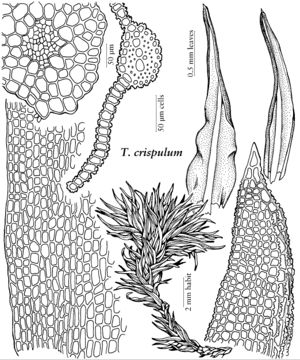Trichostomum crispulum
Flora 12: 395, fig. 4. 1829,.
Stem rounded-pentagonal in section. Leaves naviculate, ovate to ovatelanceolate or longlanceolate, distal margins erect, entire, not bordered; apex blunt or rounded-acute, seldom acute, cucullate; basal-cells differentiated across leaf base as a U, commonly running up margins as a very narrow band of nonpapillose cells, not distinctly enlarged submarginally; distal laminal cells pluripapillose with low papillae; mucro conic, of 3–6 cells. Sexual condition dioicous; known only from perichaetiate plants in the flora area.
Habitat: Igneous and basic rock, soil, silt, frost boil, tundra, cliffs
Distribution

Greenland, Man., N.W.T., Ont., Yukon, Ala., Alaska, Ariz., Calif., Fla., Tex., Vt., Mexico, West Indies, Central America, Eurasia, Africa, Atlantic Islands, Pacific Islands
Discussion
Small plants of Trichostomum crispulum lacking sex organs may easily be mistaken for Weissia, but the cucullate apex and often chestnut brown costa of the former are fairly good characters. However, Weissia crispula Hedwig is not synonymous with Trichostomum crispulum. All Arctic specimens seen that had been identified as Weissia controversa are referred here to T. crispulum. This taxon has previously been considered rare in the New World; however, it is common in Mexico (R. H. Zander 1994e), where it has been known under various synonyms. Trichostomum crispulum is matched in size by the similar Weissia sharpii, which is distinguished by the incurved distal laminal margins. Trichostomum crispulum in the flora area differs from populations in Europe by the stem either black or brown (in Europe usually black), the adaxial costal cells more often entirely elongate or of quadrate cells in a patch at mid leaf and the distal abaxial surface of the costa sometimes rather papillose. In Mexico, this species fruits and produces a somewhat more robust peristome than in Europe, attaining 400 to 500 µm, seldom reduced or rudimentary as it commonly is in Europe. The length of peristomes, 350–450 µm, of Japanese specimens (K. Saito 1975), however, are easily within the range of variation of American populations. Weissia jamaicensis has much the same well-developed peristome as does New World T. crispulum, and, in Mexico and portions of the southern United States, W. jamaicensis intergrades with T. crispulum, having broadly lanceolate leaves with weakly inflexed distal margins, though retaining the characteristic strong and bulging adaxial stereid band of the costa. The merely erect (not sharply incurved) leaf margin of T. crispulum reveals the characteristic nonpapillose margin about 1 cell wide extending from the base to mid leaf. This also occurs in T. brittonianum. The specimens identified as T. brittonianum from Florida are, however, sterile and are not gametophytically distinct from T. crispulum.
Selected References
None.
